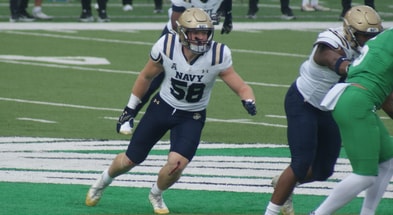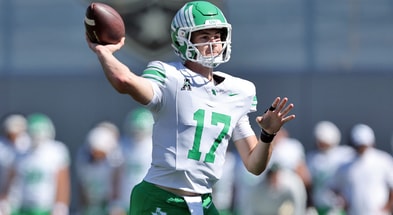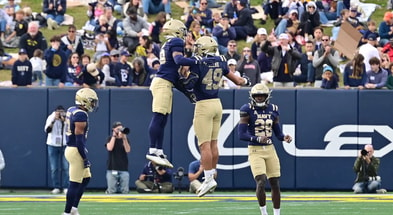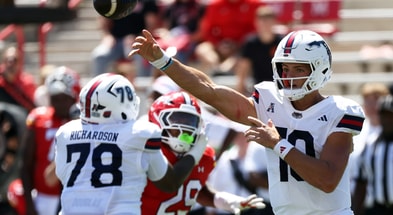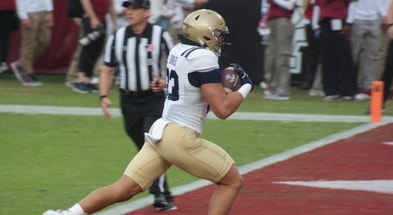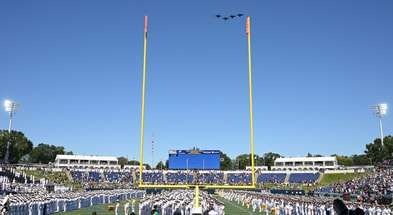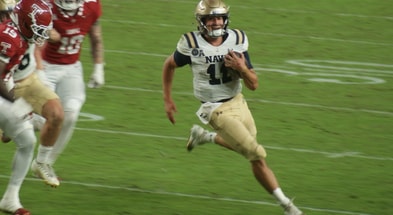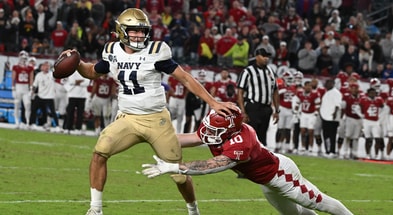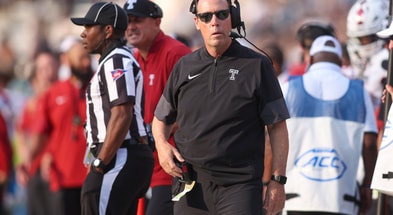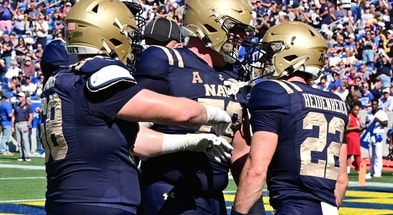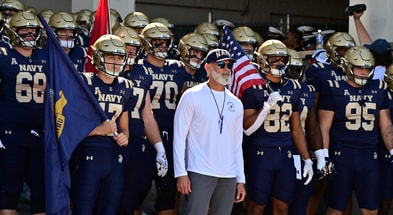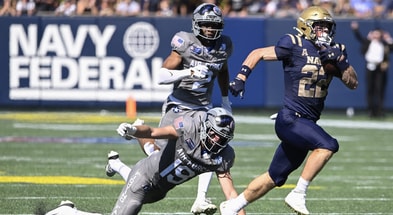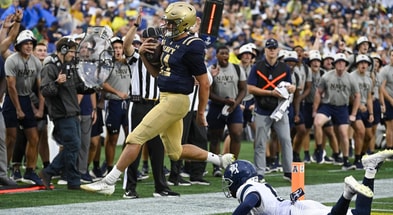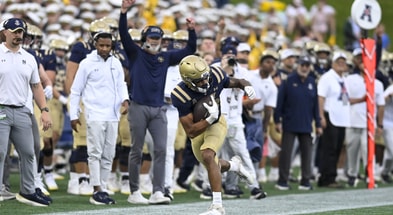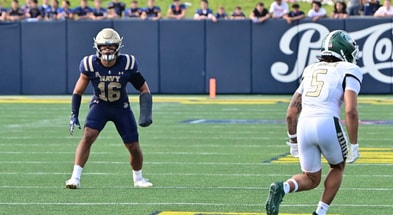The North Texas Debrief
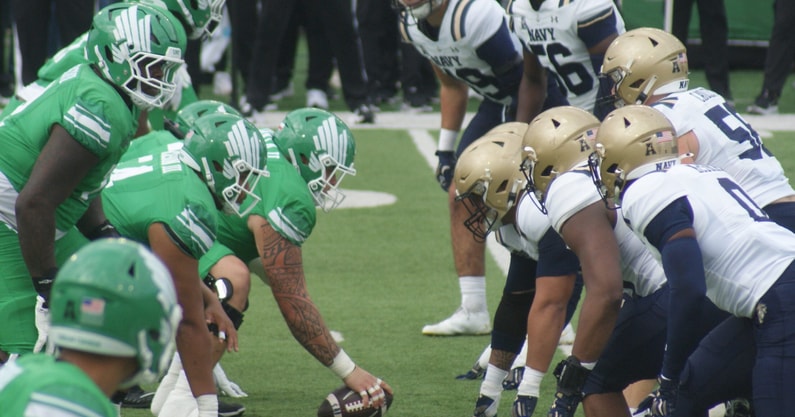
When I first started compiling these game debriefs years ago, I did so mostly out of frustration. I would read message board hot takes and commentary in the media talking about what went right or wrong in a game and think to myself, “That’s not what happened at all!” So I set about trying to explain games the way I saw them as best I could, and eventually it evolved into the sprawling media empire you know today as The Mid Report dot com. You can decide for yourself whether the world is any better off for it.
But while hot takes are often wrong, sometimes they’re right. And if your initial reaction on Saturday was that Navy’s offensive miscues cost them the game, well, you won’t get an argument from me.
Indeed, a glance at the stats would show a fairly even matchup. The Mids ran for 311 yards, which is right around their season average. North Texas outgained Navy, 424-391, but Navy averaged 6.7 yards per play to the Mean Green’s 6.1. Both teams had 22 first downs. But the devil was in the details. While UNT went 5-5 in the red zone, Navy was 2-4. The Mids had three turnovers, while the Mean Green had none. Navy also had eight penalties, continuing a season-long trend. We’ve discussed all season how the Mids would eventually face a team that wouldn’t let them recover from their mistakes, and on Saturday, it finally happened.
As a whole, it looked like Navy went into the game with a reasonably solid plan. One of the things we talked about in the preview was that North Texas’s running game is what sets them apart from other Air Raid teams. They don’t run to keep defenses honest; they’re committed to it. I believe the Mids went into the game counting on that. The strategy was to turn the game into a duel of rushing offenses, counting on the #1 rushing offense in the country to live up to its ranking.
As frustrating as it was to watch Caleb Hawkins run for 197 yards, I think it was a risk Navy was willing to take. At the beginning of the game, the defense only had five players in the tackle box, either with three on the line and two linebackers, or four and one.
They put six in the box later in the game, but either way, they were daring North Texas to be dedicated to the run. To UNT’s credit, they were. But overall, it still had the effect that Navy intended. The 31 points the Mean Green put up were the fewest they had scored all season. Their 424 yards were 63 fewer than their average. That’s not to say the defense played well, because there were issues with tackling and run fits. However, they also regained possession of the ball for the offense in the third quarter, giving them a chance to tie the game. Navy’s offense had eight possessions, which should have been enough for them to put up 31 points of their own. Alas, they couldn’t do it.
A lot of credit for that has to go to North Texas’ defense. In the preview, we looked at how they lined up against Army and speculated that they wouldn’t want to do the same against Navy. I was wrong. Well, partly. The Mean Green continued to rotate between three different looks: an odd front, an even front, and an even front with double 3-techs. And it’s when they came closest to replicating what they did against Army that the Mids had some of their best plays.
We saw in the preview how North Texas would have a linebacker attack a gap at the line of scrimmage after the snap against Army. When they did that against Navy, the Mids just ran around him.
And when the Mean Green lined up with double 3-techs, the Mids ran the midline option.
However, unlike the Army game, this wasn’t the bulk of North Texas’s game plan. It seems that the Mean Green learned a few lessons from their earlier game at West Point. In particular, they were a lot more disciplined.
You could see it in their secondary. On the first play here, Navy tries to get a two-for-one block on an end-around by getting the cornerback to follow the receiver to the safety. But the cornerback recognizes the play and makes the stop before it turns into a bigger gain. On the second play, a defensive back holds his ground against two Navy blockers, allowing others to swarm to the ball.
But the most significant improvement in the North Texas defense was from their linebackers.
Navy’s offense doesn’t try to block every defender on every play. They use misdirection to get defenders, especially linebackers, running the wrong way. That allows them to bring more blockers to where the ball is actually going, which is a big reason why they’re able to generate so many explosive plays.
However, North Texas seldom fell for the misdirection. Their linebackers were dialed into their keys and aggressive once they read them.
The Mids were able to slow down the linebackers somewhat using the counter option. The counter action forces those linebackers to read the play for a split second longer, which was just enough time for blockers to get out ahead of them.
However, the problem with the counter option is that it loses its effectiveness the more it’s run. Eventually, defenses begin to recognize it, and they react more quickly to it.
Now, it’s not as if having disciplined linebackers is the singular answer to Navy’s offense. As I mentioned, the Navy offense ran for 311 yards, averaging 7.1 yards per rush. But the linebacker discipline made it more of a power game for the Mids. We saw a lot of fullback bounce, off tackle, and QB power from them. And, for the most part, it worked. But forcing Navy to rely on power running took away the explosive element from the running game. The Mids had to drive the field 5-6 yards at a time, and that’s where the mistakes entered the picture. The more plays it took to drive the field, the more opportunities there were for errors. And if you aren’t generating explosive plays, 5-yard false start penalties have a bigger impact.
Even with all that, though, the Mids still had chances in the fourth quarter to get back into the game. In both these situations, North Texas came up with a big play.
Here, the Mids faced 4th and 2 from the nine-yard line with more than ten minutes left to play. They ran the power read, and Blake Horvath chose to keep the ball. But his key on the play, the outside linebacker, squatted; he was reading Horvath as Horvath was reading him. When the quarterback decided to keep the ball, the OLB was able to react quickly enough to make the stop.
That was a good individual play, but North Texas also made some shrewd coaching moves. The Mids had another chance inside the red zone later in the quarter. On first down from the North Texas 17, Navy took to the air. At the snap, it looked like they had man coverage. The closest safety to Eli Heidenreich was in between the hash marks, so a fade to 22 looked like a great idea. The problem is that it wasn’t man coverage. It was a well-disguised cover 2. Instead of the safety having deep responsibility, it was the nickel lined up over the slot. I don’t think Horvath even saw him. The cornerback lined up over Heidenreich even took a quick step inside, which made it appear to be a corner blitz. That only reinforced the decision to throw to Heidenreich.
Sometimes you just have to tip your cap to a great call.
Although the result was disappointing, the damage was limited in the context of the conference race. Six schools have one conference loss, so Navy is still right in the thick of things. Teams will be playing each other over the next month, so that will all get sorted out. While both of the league teams remaining on Navy’s schedule are enormous challenges (USF, Memphis), if Navy wins, they’ll have considerable tiebreaker advantages. The silver lining may be small, but it’s there.
In the meantime, the Mids don’t exactly have time to dwell on the result with a trip to South Bend this weekend. That’s probably a good thing; there’s nothing better for getting refocused than putting another big obstacle in your path. There were some hard lessons from this game, and if Navy wants to remain a conference contender, they’ll need to learn them in a hurry.
